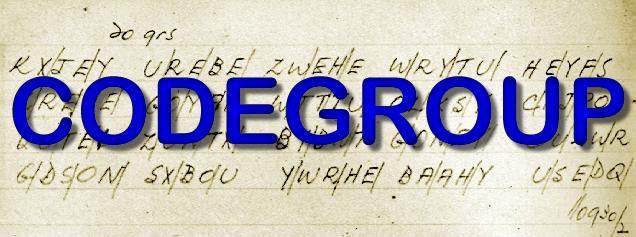
This page describes a program, codegroup, which encodes and decodes arbitrary binary data in five-letter code groups, just like spies use.
For decades, spies have written their encoded messages in groups of five letters.
codegroup encodes any file into this form, allowing it to be transmitted through any medium, and decodes files containing codegroups into the original input. Encoded files contain a 16-bit cyclical redundancy check (CRC) and file size to verify, when decoded, that the message is complete and correct. Files being decoded may contain other information before and after the codegroups, allowing in-the-clear annotations to be included.
codegroup makes no attempt, on its own, to prevent your message from being read. Cryptographic security should be delegated to a package intended for that purpose, such as pgp. codegroup can then be applied to the encrypted binary output, transforming it into easily transmitted text. Text created by codegroup uses only upper case ASCII letters and spaces. Unlike files encoded with uuencode or pgp's “ASCII armour” facility, the output of codegroup can be easily (albeit tediously) read over the telephone, broadcast by shortwave radio to agents in the field, or sent by telegram, telex, or Morse code.
To illustrate the difference, here are the first few lines of a binary file encoded by:
Only codegroup conforms to the telegraphic convention of all upper case letters, and passes the “telephone test” of being readable without any modifiers such as “capital” and “lower-case”. Avoiding punctuation marks and lower case letters makes the output of codegroup much easier to transmit over a voice or traditional telegraphic link.
Encoding a binary file as ASCII characters inevitably increases its size. When used in conjunction with existing compression and encryption tools, the resulting growth in file size is usually acceptable. For example, a random extract of electronic mail 32768 bytes in length was chosen as a test sample. Compression with gzip compacted the file to 15062 bytes. It was then encrypted for transmission to a single recipient with pgp, which resulted in a 15233 byte file. (Even though pgp has its own compression, smaller files usually result from initial compression with gzip. In this case, pgp alone would have produced a file of 15420 bytes.)
codegroup transforms the encrypted file into a 37296 byte text file. Thus, due to compression, the code groups for the encrypted file are only a little larger than the original cleartext.
Restricting the character set to upper case letters and including spaces between groups results in substantially larger output files than those produced by uuencode and pgp. Files encoded with codegroup are about 2.5 times the size of the input file, while uuencode and pgp expand the file only about 35%. codegroup is thus preferable only for applications where its limited character set is an advantage.
If no infile is specified or infile is a single “-”, codegroup reads from standard input; if no outfile is given, or outfile is a single “-”, output is sent to standard output. Input and output are processed strictly serially; consequently codegroup may be used in pipelines.
When a CRC error is detected, no indication is given of the location in the file where the error(s) occurred. When sending large files, you may want to break them into pieces with the splits utility so, in case of error, only the erroneous pieces need to be re-sent.
It might be nice to embed the original file name and modes in the encoded output, but this opens the door to all kinds of system-dependent problems. You can always include this information as text before the first codegroup, or send an archive created with tar or zip.
The program is provided as codegroup.zip, a
Zipped archive containing an
ready-to-run WIN32 command-line executable program, codegrp.exe
(compiled using Microsoft Visual C++ 5.0),
and in source code form along with a
Makefile to build the program under Unix.
codegroup returns status 0 if processing was completed without errors, 1 if errors were detected in decoding a file which indicate the output is incorrect or incomplete, and 2 if processing could not be performed at all due, for example, to a nonexistent input file or no codegroups found in the input.